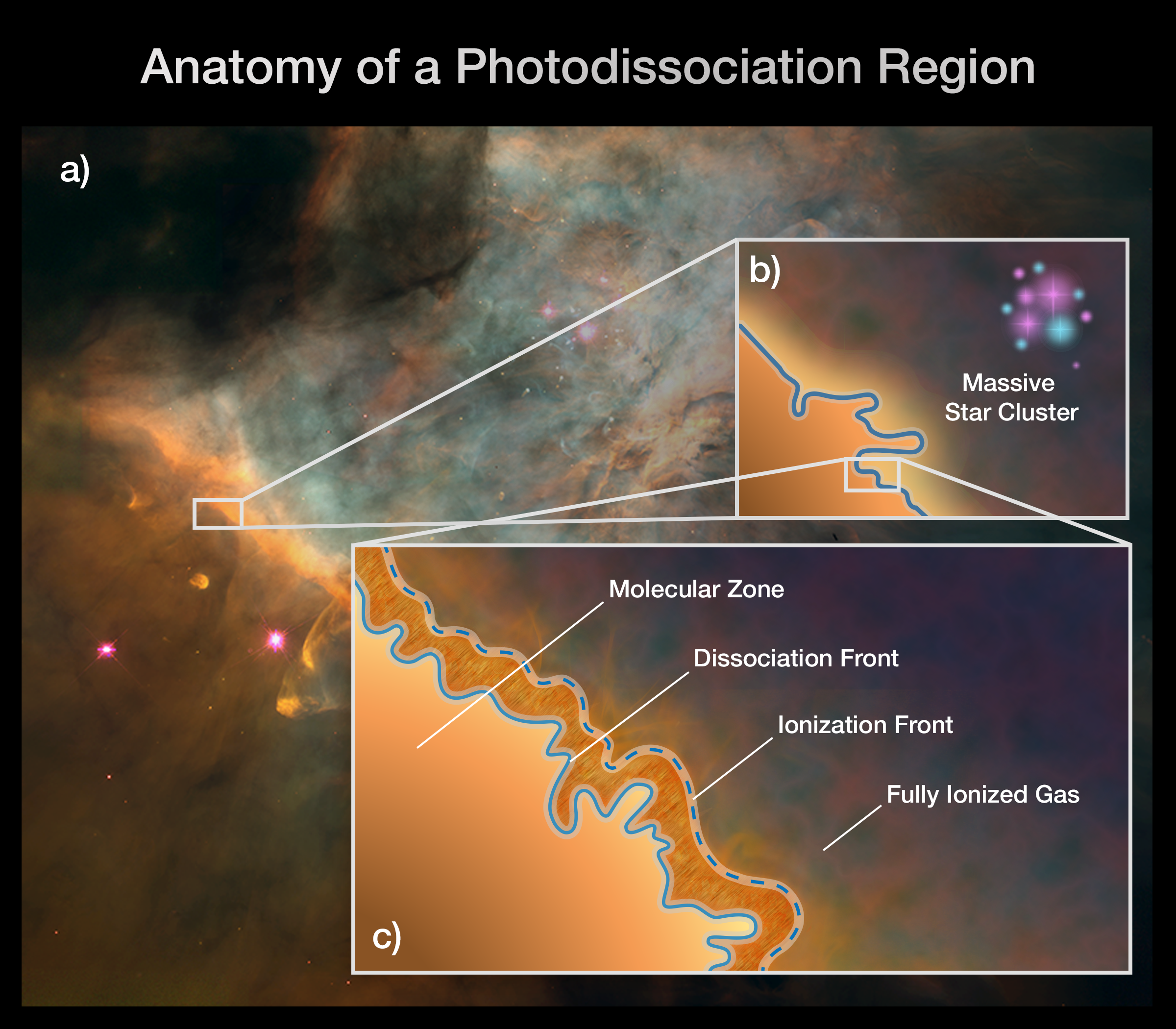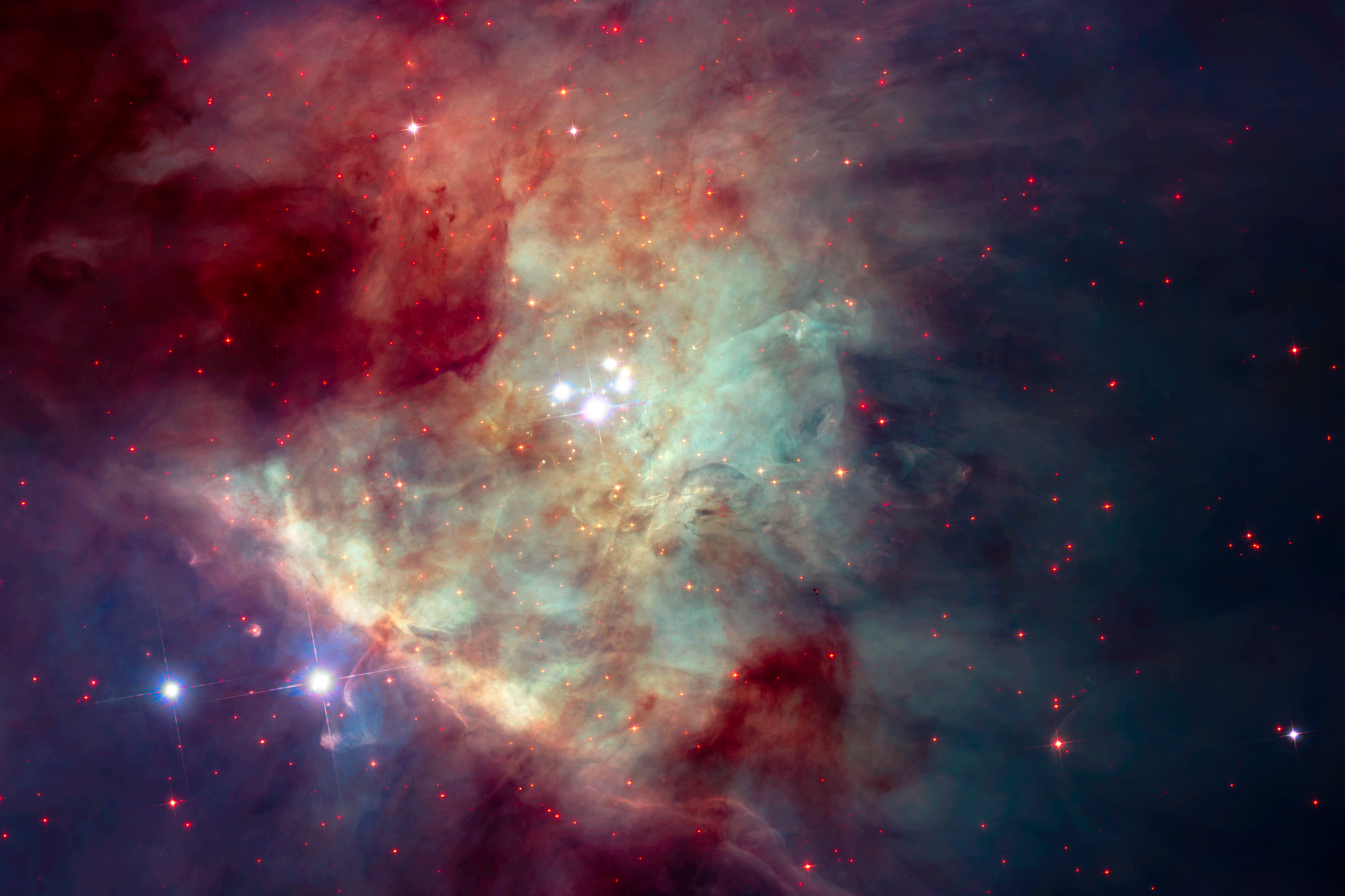1 min read
Anatomy of a Photodissociation Region

This graphic depicts the stratified nature of a photodissociation region (PDR) such as the Orion Bar. Once thought to be homogenous areas of warm gas and dust, PDRs are now known to contain complex structure and four distinct zones. The box at the left shows a portion of the Orion Bar within the Orion Nebula. The box at the top right illustrates a massive star-forming region whose blasts of ultraviolet radiation are affecting a PDR. The box at the bottom right zooms in on a PDR to depict its four, distinct zones: 1) the molecular zone, a cold and dense region where the gas is in the form of molecules and where stars could form; 2) the dissociation front, where the molecules break apart into atoms as the temperature rises; 3) the ionization front, where the gas is stripped of electrons, becoming ionized, as the temperature increases dramatically; and 4) the fully ionized flow of gas into a region of atomic, ionized hydrogen. For the first time, Webb will be able to separate and study these different zones' physical conditions.
Extended Description and Image Alt Text
Extended Description
Titled "Anatomy of a Photodissociation Region," this graphic depicts the stratified nature of a photodissociation region in the Orion Nebula.
The main image, labeled "A," is a stellar nursery filled with gas, dust, and massive, young stars. The area is clouded with orange, gray, and blue-green dust and gas. It is punctuated with bright pink and orange clusters of massive, young stars. The image is overlaid with a small white box toward the left, which connects to a box labeled "B" toward the top right.
Box B illustrates a massive star-forming region whose blasts of ultraviolet radiation are affecting a photodissociation region. The box contains a cartoon illustrating this concept. At the bottom left corner of the box is an irregular, deep orange area, which has its right edge outlined in blue. To the right of the blue solid line is a cloudy, yellowish region running almost diagonally from the top left to the bottom right. Beyond the yellowish region is a large area mottled with red, green, and black blotches. Sitting at the top of this mottled area, in the right corner of the box, are pink and light blue stars. The stars are labeled "Massive Star Cluster." A small white box in the bottom left corner highlights an area within Box B, which connects to a box labeled "C" in the bottom right.
Box C shows the four distinct zones of a photodissociation region. At the bottom left corner of the box is an irregular, deep orange area. A blue solid line runs along the orange area’s right edge, starting at top left and ending toward the bottom in the center. The deep orange area is labeled "Molecular Zone," and the blue solid line is labeled "Dissociation Front." To the right of the blue line is an orange-brown layer of material. This layer has a blue dashed line running along its right edge. The line is labeled "Ionization Front." Beyond is a large area mottled with red, green, and black blotches. It is labeled "Fully Ionized Gas."
Image Alt Text
The main image, labeled "A," takes up almost the entire frame and shows a stellar nursery within the Orion Nebula, a region filled with gas, dust, and massive, young stars. The area is clouded with orange, gray, and blue-green dust and gas. It is punctuated with bright pink and orange clusters of massive, young stars. The main image is overlaid with a small white box toward the left, which connects to a box labeled "B" toward the top right. Box B illustrates a massive star-forming region whose blasts of ultraviolet radiation are affecting a photodissociation region. A small white box highlights an area within Box B, which connects to a box labeled "C" in the bottom right. Box C zooms in on a photodissociation region to depict its four distinct zones. Select View Description for more details.
- Release DateMay 19, 2021
- Science ReleaseNASA’s Webb to Study How Massive Stars’ Blasts of Radiation Influence Their Environments
- CreditIllustration: NASA, ESA, CSA, PDRs4ALL ERS Team, Jason Champion (CNRS), Pam Jeffries (STScI)
Related Images & Videos
Share
Details
Laura Betz
NASA’s Goddard Space Flight Center
Greenbelt, Maryland
laura.e.betz@nasa.gov
NASA, ESA, CSA, PDRs4ALL ERS Team, Jason Champion (CNRS), Pam Jeffries (STScI)































